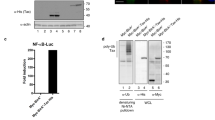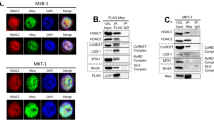Abstract
Sequence-specific single-stranded DNA-binding protein 2 (SSBP2) is a candidate tumor suppressor for human acute myelogenous leukemia (AML). Inducible expression of SSBP2 causes growth arrest and partial differentiation in AML cells. Here, we report that the adenoviral oncoprotein E1B55K directly binds to endogenous SSBP2 protein and sequesters it into juxtanuclear bodies in adenovirally transformed human embryonic kidney (HEK) 293 cells. Similarly, transient expression of E1B55K in IMR90 fibroblasts and HeLa cells result in the formation of juxtanuclear bodies containing SSBP2. When nuclear export of E1B55K is prevented, SSBP2 remains associated with E1B55K in nuclear foci. A requirement for intact microtubules to retain the integrity of the juxtanuclear bodies suggests them to be E1B55K containing aggresomes. The adenoviral E1B55K protein has been shown to localize to the Mre11 complex and p53 to aggresome structures; together with the viral E4orf6 protein, E1B55K recruits a cellular E3 ubiquitin ligase that induces degradation of Mre11 and p53. However, our present studies reveal that E1B55K does not degrade SSBP2. These data demonstrate that E1B55K targets the candidate leukemia suppressor SSBP2 and suggest that subverting its function may contribute to cell transformation by viral oncoproteins.
This is a preview of subscription content, access via your institution
Access options
Subscribe to this journal
Receive 50 print issues and online access
$259.00 per year
only $5.18 per issue
Buy this article
- Purchase on Springer Link
- Instant access to full article PDF
Prices may be subject to local taxes which are calculated during checkout






Similar content being viewed by others
References
Ahuja D, Saenz-Robles MT, Pipas JM . (2005). SV40 large T antigen targets multiple cellular pathways to elicit cellular transformation. Oncogene 24: 7729–7745.
Araujo FD, Stracker TH, Carson CT, Lee DV, Weitzman MD . (2005). Adenovirus type 5 E4orf3 protein targets the Mre11 complex to cytoplasmic aggresomes. J Virol 79: 11382–11391.
Bayarsaihan D, Lukens LN . (1996). Single-strand-DNA-binding factors specifically recognize the pyrimidine element in the chick alpha2(I) collagen gene promoter. Biochem J 314 (Part 1): 293–296.
Brown CR, Doxsey SJ, White E, Welch WJ . (1994). Both viral (adenovirus E1B) and cellular (hsp 70, p53) components interact with centrosomes. J Cell Physiol 160: 47–60.
Carson CT, Schwartz RA, Stracker TH, Lilley CE, Lee DV, Weitzman MD . (2003). The Mre11 complex is required for ATM activation and the G2/M checkpoint. EMBO J 22: 6610–6620.
Castro P, Liang H, Liang JC, Nagarajan L . (2002). A novel, evolutionarily conserved gene family with putative sequence-specific single-stranded DNA-binding activity. Genomics 80: 78–85.
Cathomen T, Weitzman MD . (2000). A functional complex of adenovirus proteins E1B-55kDa and E4orf6 is necessary to modulate the expression level of p53 but not its transcriptional activity. J Virol 74: 11407–11412.
Chen L, Segal D, Hukriede NA, Podtelejnikov AV, Bayarsaihan D, Kennison JA et al. (2002). Ssdp proteins interact with the LIM-domain-binding protein Ldb1 to regulate development. Proc Natl Acad Sci USA 99: 14320–14325.
Dobner T, Kzhyshkowska J . (2001). Nuclear export of adenovirus RNA. Curr Top Microbiol Immunol 259: 25–54.
Dosch T, Horn F, Schneider G, Kratzer F, Dobner T, Hauber J et al. (2001). The adenovirus type 5 E1B-55K oncoprotein actively shuttles in virus-infected cells, whereas transport of E4orf6 is mediated by a CRM1-independent mechanism. J Virol 75: 5677–5683.
Endter C, Dobner T . (2004). Cell transformation by human adenoviruses. Curr Top Microbiol Immunol 273: 163–214.
Endter C, Hartl B, Spruss T, Hauber J, Dobner T . (2005). Blockage of CRM1-dependent nuclear export of the adenovirus type 5 early region 1B 55-kDa protein augments oncogenic transformation of primary rat cells. Oncogene 24: 55–64.
Felsani A, Mileo AM, Paggi MG . (2006). Retinoblastoma family proteins as key targets of the small DNA virus oncoproteins. Oncogene 25: 5277–5285.
Flint SJ, Gonzalez RA . (2003). Regulation of mRNA production by the adenoviral E1B 55-kDa and E4 Orf6 proteins. Curr Top Microbiol Immunol 272: 287–330.
Goardon N, Lambert JA, Rodriguez P, Nissaire P, Herblot S, Thibault P et al. (2006). ETO2 coordinates cellular proliferation and differentiation during erythropoiesis. EMBO J 25: 357–366.
Harada JN, Shevchenko A, Pallas DC, Berk AJ . (2002). Analysis of the adenovirus E1B-55K-anchored proteome reveals its link to ubiquitination machinery. J Virol 76: 9194–9206.
Kopito RR . (2000). Aggresomes, inclusion bodies and protein aggregation. Trends Cell Biol 10: 524–530.
Kratzer F, Rosorius O, Heger P, Hirschmann N, Dobner T, Hauber J et al. (2000). The adenovirus type 5 E1B-55K oncoprotein is a highly active shuttle protein and shuttling is independent of E4orf6, p53 and Mdm2. Oncogene 19: 850–857.
Liang H, Samanta S, Nagarajan L . (2005). SSBP2, a candidate tumor suppressor gene, induces growth arrest and differentiation of myeloid leukemia cells. Oncogene 24: 2625–2634.
Liu Y, Shevchenko A, Berk AJ . (2005). Adenovirus exploits the cellular aggresome response to accelerate inactivation of the MRN complex. J Virol 79: 14004–14016.
Martin ME, Berk AJ . (1998). Adenovirus E1B 55K represses p53 activation in vitro. J Virol 72: 3146–3154.
Nishioka N, Nagano S, Nakayama R, Kiyonari H, Ijiri T, Taniguchi K et al. (2005). Ssdp1 regulates head morphogenesis of mouse embryos by activating the Lim1–Ldb1 complex. Development 132: 2535–2546.
Ornelles DA, Shenk T . (1991). Localization of the adenovirus early region 1B 55-kilodalton protein during lytic infection: association with nuclear viral inclusions requires the early region 4 34-kilodalton protein. J Virol 65: 424–429.
O'Shea CC . (2005). DNA tumor viruses – the spies who lyse us. Curr Opin Genet Dev 15: 18–26.
Querido E, Blanchette P, Yan Q, Kamura T, Morrison M, Boivin D et al. (2001a). Degradation of p53 by adenovirus E4orf6 and E1B55K proteins occurs via a novel mechanism involving a Cullin-containing complex. Genes Dev 15: 3104–3117.
Querido E, Marcellus RC, Lai A, Charbonneau R, Teodoro JG, Ketner G et al. (1997). Regulation of p53 levels by the E1B 55-kilodalton protein and E4orf6 in adenovirus-infected cells. J Virol 71: 3788–3798.
Querido E, Morrison MR, Chu-Pham-Dang H, Thirlwell SW, Boivin D, Branton PE . (2001b). Identification of three functions of the adenovirus e4orf6 protein that mediate p53 degradation by the E4orf6–E1B55K complex. J Virol 75: 699–709.
Sarnow P, Sullivan CA, Levine AJ . (1982). A monoclonal antibody detecting the adenovirus type 5-E1b-58Kd tumor antigen: characterization of the E1b-58Kd tumor antigen in adenovirus-infected and -transformed cells. Virology 120: 510–517.
Schuh AH, Tipping AJ, Clark AJ, Hamlett I, Guyot B, Iborra FJ et al. (2005). ETO-2 associates with SCL in erythroid cells and megakaryocytes and provides repressor functions in erythropoiesis. Mol Cell Biol 25: 10235–10250.
Steegenga WT, Riteco N, Jochemsen AG, Fallaux FJ, Bos JL . (1998). The large E1B protein together with the E4orf6 protein target p53 for active degradation in adenovirus infected cells. Oncogene 16: 349–357.
Steegenga WT, Shvarts A, Riteco N, Bos JL, Jochemsen AG . (1999). Distinct regulation of p53 and p73 activity by adenovirus E1A, E1B, and E4orf6 proteins. Mol Cell Biol 19: 3885–3894.
Stracker TH, Carson CT, Weitzman MD . (2002). Adenovirus oncoproteins inactivate the Mre11-Rad50-NBS1 DNA repair complex. Nature 418: 348–352.
Teodoro JG, Branton PE . (1997). Regulation of p53-dependent apoptosis, transcriptional repression, and cell transformation by phosphorylation of the 55-kilodalton E1B protein of human adenovirus type 5. J Virol 71: 3620–3627.
van Meyel DJ, Thomas JB, Agulnick AD . (2003). Ssdp proteins bind to LIM-interacting co-factors and regulate the activity of LIM-homeodomain protein complexes in vivo. Development 130: 1915–1925.
Weitzman MD, Ornelles DA . (2005). Inactivating intracellular antiviral responses during adenovirus infection. Oncogene 24: 7686–7696.
Wienzek S, Roth J, Dobbelstein M . (2000). E1B 55-kilodalton oncoproteins of adenovirus types 5 and 12 inactivate and relocalize p53, but not p51 or p73, and cooperate with E4orf6 proteins to destabilize p53. J Virol 74: 193–202.
Wu L . (2006). Structure and functional characterization of single-strand DNA binding protein SSDP1: carboxyl-terminal of SSDP1 has transcription activity. Biochem Biophys Res Commun 339: 977–984.
Yew PR, Berk AJ . (1992). Inhibition of p53 transactivation required for transformation by adenovirus early 1B protein. Nature 357: 82–85.
Yew PR, Liu X, Berk AJ . (1994). Adenovirus E1B oncoprotein tethers a transcriptional repression domain to p53. Genes Dev 8: 190–202.
Zantema A, Fransen JA, Davis-Olivier A, Ramaekers FC, Vooijs GP, DeLeys B et al. (1985). Localization of the E1B proteins of adenovirus 5 in transformed cells, as revealed by interaction with monoclonal antibodies. Virology 142: 44–58.
Zhao LY, Colosimo AL, Liu Y, Wan Y, Liao D . (2003). Adenovirus E1B 55-kilodalton oncoprotein binds to Daxx and eliminates enhancement of p53-dependent transcription by Daxx. J Virol 77: 11809–11821.
Acknowledgements
We thank V Malhotra, members of the Nagarajan and Weitzman labs for helpful discussions during the course of this work and for critical reading of the manuscript. We thank V Lundblad and her lab for help with two-hybrid experiments and R Schwartz for help with degradation experiment. Work in the Nagarajan laboratory was supported by NIH Grant HL074449. The automated DNA sequencing core facility at MD Anderson cancer center supported by core grant CA16672 is acknowledged for verification of expression of constructs. MDW acknowledges the James B Pendleton Charitable Trust for providing the microscopy suite. Work in the lab of MDW was supported in part by NIH Grant CA97093. NIO was supported by an NIH Training Grant (T32 CA064041) and a fellowship from the Chapman Charitable Trust.
Author information
Authors and Affiliations
Corresponding author
Rights and permissions
About this article
Cite this article
Fleisig, H., Orazio, N., Liang, H. et al. Adenoviral E1B55K oncoprotein sequesters candidate leukemia suppressor sequence-specific single-stranded DNA-binding protein 2 into aggresomes. Oncogene 26, 4797–4805 (2007). https://doi.org/10.1038/sj.onc.1210281
Received:
Revised:
Accepted:
Published:
Issue Date:
DOI: https://doi.org/10.1038/sj.onc.1210281



